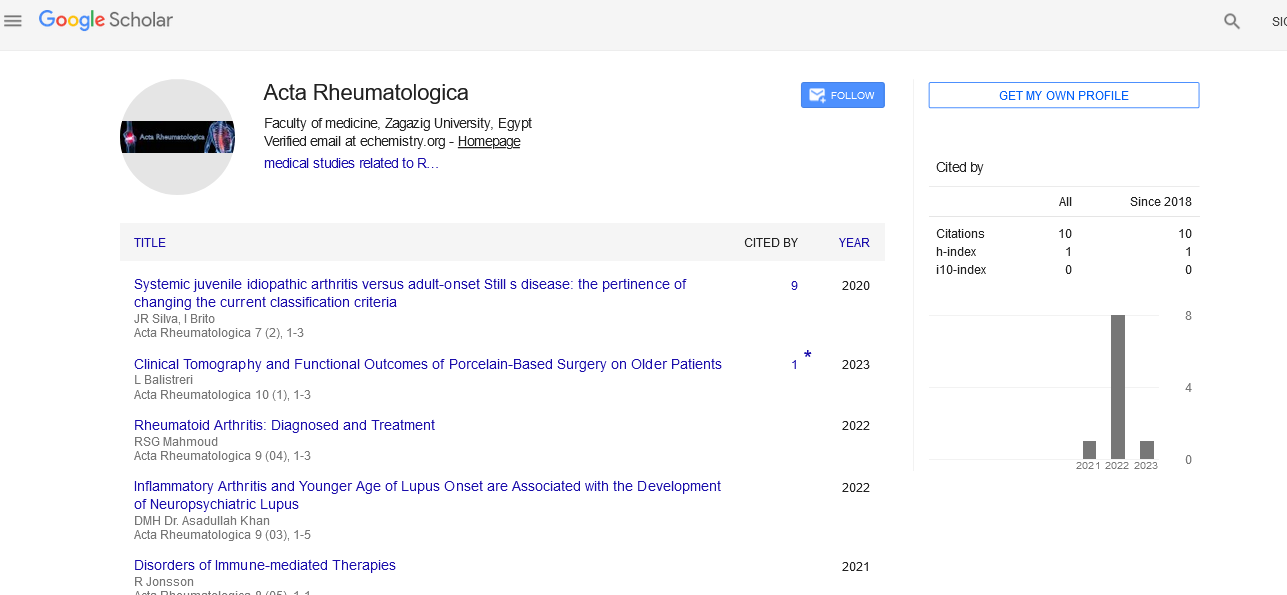Perspective - (2024) Volume 11, Issue 1
Unraveling the Enigma of Ankylosing Spondylitis: A Comprehensive Exploration
Yi Jin*
Department of Rheumatology, Nanjing Medical University, Jiangsu, China
*Correspondence:
Yi Jin, Department of Rheumatology, Nanjing Medical University, Jiangsu,
China,
Email:
Received: 03-Jan-2024, Manuscript No. IPAR-24-14409;
Editor assigned: 08-Jan-2024, Pre QC No. IPAR-24-14409 (PQ);
Reviewed: 23-Jan-2024, QC No. IPAR-24-14409;
Revised: 31-Jan-2024, Manuscript No. IPAR-24-14409 (R);
Published:
08-Feb-2024
Introduction
Ankylosing Spondylitis (AS) is a chronic inflammatory arthritis
primarily affecting the spine, characterized by pain, stiffness,
and, in severe cases, fusion of the vertebrae. This enigmatic
condition poses challenges for both patients and healthcare
professionals, requiring a nuanced understanding of its origins,
symptoms, diagnosis, and treatment. In this comprehensive
exploration, we delve into the intricacies of ankylosing
spondylitis, shedding light on the latest developments and
insights.
Description
Understanding ankylosing spondylitis
Etiology and risk factors: Ankylosing spondylitis has a
complex etiology with a strong genetic component. The HLA-B27
gene is a well-established genetic marker associated with
increased susceptibility. However, not everyone carrying this
gene develops AS, suggesting the involvement of environmental
factors. Smoking, for instance, has been identified as a
significant risk factor, emphasizing the interplay between
genetics and lifestyle.
Pathophysiology: The disease primarily targets the sacroiliac
joints, where the spine connects to the pelvis. Chronic
inflammation can lead to the formation of new bone, causing
the vertebrae to fuse over time. Understanding the
inflammatory processes involved is crucial for developing
targeted therapies to mitigate the progression of the disease.
Symptoms and clinical presentation
Pain and stiffness: Persistent lower back pain and stiffness are
hallmark symptoms of AS. The discomfort is often more
pronounced in the morning or after periods of inactivity,
gradually improving with movement. Understanding the cyclical
nature of these symptoms is vital for accurate diagnosis.
Extra-articular manifestations: Beyond the spine, AS can
affect various organs, leading to a range of extra-articular
manifestations. These may include uveitis, psoriasis, and
cardiovascular complications, highlighting the systemic nature of
the disease. Recognizing these manifestations is crucial for a
comprehensive approach to managing AS.
Diagnosis and differential diagnosis
Imaging techniques: Diagnosing ankylosing spondylitis can be
challenging, as symptoms overlap with other conditions. Imaging
techniques such as X-rays and MRI play a pivotal role in
visualizing sacroiliitis and spinal changes. Early diagnosis is
essential for initiating timely interventions to curb disease
progression.
Differential diagnosis: Distinguishing AS from other
inflammatory conditions, such as rheumatoid arthritis or
spondyloarthritis, is imperative. Understanding the nuances of
each condition aids in precise diagnosis and formulation of
tailored treatment plans.
Management strategies
Pharmacological interventions: Nonsteroidal Anti-Inflammatory Drugs (NSAIDs) are commonly used to alleviate pain
and inflammation in AS. Disease-Modifying Antirheumatic Drugs
(DMARDs) and biologics, targeting specific inflammatory
pathways, have revolutionized the management of AS, offering
improved outcomes and enhanced quality of life for patients.
Physical therapy and exercise: Exercise and physical therapy
play a pivotal role in managing ankylosing spondylitis. Targeted
exercises help maintain flexibility and posture, preventing the
debilitating effects of spinal fusion. Comprehensive
rehabilitation programs empower patients to actively participate
in their care.
Surgical interventions: In severe cases where joint damage is
irreversible, surgical interventions such as joint replacement
may be considered. These interventions aim to restore function
and alleviate pain, enhancing the overall quality of life for
individuals with advanced AS.
Lifestyle modifications and patient education
Smoking cessation: Given the established link between
smoking and AS, promoting smoking cessation is a crucial aspect
of holistic disease management. Educational initiatives targeting
both patients and healthcare providers can significantly impact
long-term outcomes.
Psychosocial support: Living with a chronic condition like AS
can have profound psychosocial implications. Establishing a robust support system and integrating mental health support
into the overall management strategy is vital for holistic care.
Future directions in ankylosing spondylitis research
Precision medicine: Advances in genetic research are paving
the way for personalized treatment approaches. Identifying
specific genetic markers and understanding their role in disease
progression holds promise for tailoring interventions to
individual patients.
Exploring novel therapeutic targets: Ongoing research is
uncovering new inflammatory pathways implicated in AS.
Exploring these pathways opens avenues for the development of
novel therapeutic agents, potentially revolutionizing treatment
modalities in the future.
Conclusion
Ankylosing spondylitis remains a challenging yet intriguing
puzzle in the realm of rheumatology. A multidisciplinary
approach, incorporating genetic insights, advanced imaging
techniques, and evolving treatment modalities, is essential for
effectively managing this complex condition. As our
understanding deepens and research progresses, the journey
towards unraveling the mysteries of Ankylosing Spondylitis
continues, holding the promise of improved outcomes and a
better quality of life for those affected by this chronic
inflammatory arthritis.
Citation: Jin Y (2024) Unraveling the Enigma of Ankylosing Spondylitis: A Comprehensive Exploration. Acta Rheuma Vol:11 No:1





